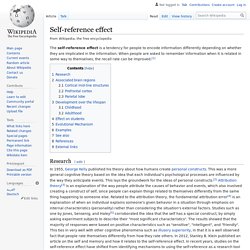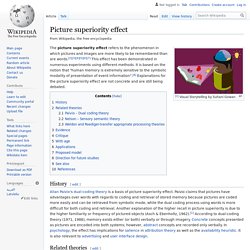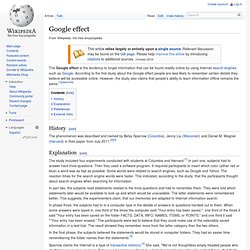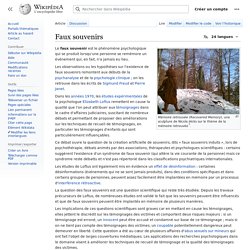

Effet Zeigarnik. L’effet Zeigarnik désigne la tendance à mieux se rappeler une tâche qu'on a réalisée si celle-ci a été interrompue alors qu'on cherche par ailleurs à la terminer.

Le fait de s'engager dans la réalisation d'une tâche crée une motivation d'achèvement qui resterait insatisfaite si la tâche est interrompue. Sous l'effet de cette motivation une tâche interrompue doit être mémorisée mieux qu'une tâche achevée.[1] L'expérimentation princeps[modifier | modifier le code] Bluma Zeigarnik, élève de Kurt Lewin demande à des enfants d’accomplir, en une journée, une série de vingt petits travaux (modeler des animaux, enfiler des perles, assembler les pièces d’un puzzle…).
La moitié des activités sont terminées, les autres restent inachevées. Autres données expérimentales[modifier | modifier le code] L'effet Zeigarnik est corrélé à la motivation : plus grande est la tendance personnelle à une forte motivation, plus l'effet est fort. Psychanalyse[modifier | modifier le code] Zeigarnik, B. (1927). Effet von Restorff. L'effet Von Restorff, nommé d'après la psychiatre Hedwig von Restorff, ou effet d'isolation, prévoit qu'un objet qui se détache d'autres, « tel un pouce levé de la main[trad 1] », est plus susceptible d'être retenu.

Il engendre ainsi un biais cognitif retenant ce qui est inhabituel, distinctif. The Verbatim Effect: People Remember Gist Better Than Details. The verbatim effect is a cognitive bias that causes people to remember the gist of information, which is its general meaning, better than they remember its exact form, which is the way the information was presented and the minor details that it involved.

For example, when people read a long text, they’re more likely to remember its core message, than they are to remember how exactly it was phrased. Effet test. Telescoping effect. Self-reference effect. Psychological model The self-reference effect is a tendency for people to encode information differently depending on whether they are implicated in the information.

When people are asked to remember information when it is related in some way to themselves, the recall rate can be improved.[1] Stéréotype. Positivity effect. Picture superiority effect. [1] Visual Storytelling by Suhani Gowan The picture superiority effect refers to the phenomenon in which pictures and images are more likely to be remembered than are words.[2][3][4][5][6][7] This effect has been demonstrated in numerous experiments using different methods.

It is based on the notion that "human memory is extremely sensitive to the symbolic modality of presentation of event information".[8] Explanations for the picture superiority effect are not concrete and are still being debated. History[edit] Allan Paivio's dual-coding theory is a basis of picture superiority effect. Paivio claims that pictures have advantages over words with regards to coding and retrieval of stored memory because pictures are coded more easily and can be retrieved from symbolic mode, while the dual coding process using words is more difficult for both coding and retrieval.
La règle de l'apogée-fin. Il y a quelques semaines, j’ai appelé ma compagnie aérienne pour modifier une réservation.

Loi de l'effet. La loi de l'effet est un des principes qui gouvernent l'apprentissage par conditionnement opérant.

La loi de l'effet postule qu'une réponse est plus susceptible d'être reproduite si elle entraîne une satisfaction pour l'organisme et d'être abandonnée s'il en résulte une insatisfaction. En d'autres termes, si la connexion « situation–réponse » est suivie d’un état de satisfaction (donc la récompense) le comportement appris a plus de chance d'être reproduit. Cette loi a été formulée en 1911 par Edward Thorndike. Syndrome de l'imposteur.
Maladie du Nobel. La maladie du Nobel, ou nobélite, est l'incapacité ou l'impossibilité, pour certains lauréats scientifiques du prix Nobel, de poursuivre des recherches scientifiques après s’être vu remettre un prix Nobel[1],[2],[3],[4].

Google effect. The Google effect is the tendency to forget information that can be found readily online by using Internet search engines such as Google.

According to the first study about the Google effect people are less likely to remember certain details they believe will be accessible online. However, the study also claims that people's ability to learn information offline remains the same.[1][dead link] History[edit] The phenomenon was described and named by Betsy Sparrow (Columbia), Jenny Liu (Wisconsin) and Daniel M. Generation effect. Faux souvenirs. Mémoire retrouvée (Recovered Memory), une sculpture de Nicola Hicks sur le thème de la mémoire retrouvée[1].

Fading affect bias. The fading affect bias, more commonly known as FAB, is a psychological phenomenon in which memories associated with negative emotions tend to be forgotten more quickly than those associated with positive emotions.[1] It is important to note that FAB only refers to the feelings one has associated with the memories and not the content of the memories themselves. [2]Early research studied FAB retrospectively, or through personal reflection, which brought about some criticism because retrospective analysis can be affected by subjective retrospective biases.
However, new research using non-retrospective recall studies have found evidence for FAB.,[1] and the phenomenon has become largely accepted. Description and background[edit] Some of the earliest evidence for the Fading Affect Bias dates back to a study by Cason (1932). Landau and Gunter (2009) showed that the FAB occurs regardless of whether the experience is shared between one person or a group of people that share that memory. Anxiety. Context effect. "THE CAT" is a classic example of context effect. We have little trouble reading "H" and "A" in their appropriate contexts, even though they take on the same form in each word. A context effect is an aspect of cognitive psychology that describes the influence of environmental factors on one's perception of a stimulus. The impact of context effects is considered to be part of top-down design. The concept is supported by the theoretical approach to perception known as constructive perception.
Context effects can impact our daily lives in many ways such as word recognition, learning abilities, memory, and object recognition. Cryptomnésie. Cette section ou cet article est une traduction incomplète(décembre 2016). Vous pouvez modifier la page pour effectuer la traduction. Effet von Restorff. Bizarreness effect. Bizarreness effect is the tendency of bizarre material to be better remembered than common material.[1] The scientific evidence for its existence is contested. Some research suggests it does exist, some suggests it doesn't exist and some suggests it leads to worse remembering.[2] Worse-than-average effect. Trait ascription bias. Trait ascription bias is the tendency for people to view themselves as relatively variable in terms of personality, behavior and mood while viewing others as much more predictable in their personal traits across different situations.[1] More specifically, it is a tendency to describe one's own behaviour in terms of situational factors while preferring to describe another's behaviour by ascribing fixed dispositions to their personality.
This may occur because peoples' own internal states are more readily observable and available to them than those of others. Théorie de la justification du système. La théorie de la justification du système (System Justification Theory en anglais, souvent abrégée SJT) est une théorie, en psychologie sociale, selon laquelle les inclinations et croyances justifiant un système ont une fonction psychologiquement palliative[1] : « les gens s’engagent dans la justification du système (ainsi que dans d’autres formes de rationalisation) afin de faire face et de s’adapter à des réalités injustes ou déplaisantes qui apparaissent inévitables[2]. » Cette théorie soutient que les personnes ont plusieurs besoins sous-jacents, qui varient d'un individu à l'autre, et qui peuvent être satisfaits par la défense du système social dans lequel elles vivent, et par la justification du statu quo amenant au maintien du système, même lorsque celui-ci est désavantageux pour certains groupes sociaux.
Shared information bias. Shared information bias (also known as the collective information sampling bias, or common-information bias) is known as the tendency for group members to spend more time and energy discussing information that all members are already familiar with (i.e., shared information), and less time and energy discussing information that only some members are aware of (i.e., unshared information).[1][2] Harmful consequences related to poor decision-making can arise when the group does not have access to unshared information (hidden profiles) in order to make a well-informed decision.[1][3] Causes[edit] The shared information bias may also develop during group discussion in response to the interpersonal and psychological needs of individual group members.
Surrogation. First usage[edit] Inspired by work by Yuji Ijiri, the term surrogation was coined by Willie Choi, Gary Hecht, and Bill Tayler in their paper, "Lost in Translation: The Effects of Incentive Compensation on Strategy Surrogation".[2] They show managers tend to use measures as surrogates for strategy, acting as if measures were in fact the strategy when making optimization decisions.
Puritanical bias. Puritanical bias refers to the tendency to attribute cause of an undesirable outcome or wrongdoing by an individual to a moral deficiency or lack of self control rather than taking into account the impact of broader societal determinants.[1] [2] An example might be, "These people sit around all day in their apartments on welfare watching TV, but won't take the time to get out and find a job!
" In this case, a selection of persons might have existed for some time under dire economic and/or socially oppressive circumstances, but individuals from that selection have been cognitively dis-empowered by these circumstances to decide or act on decisions to obtain a given goal. Out-group homogeneity. Perception of out-group members as being similar to each other Empirical support[edit] Racial investigation[edit] Explanations[edit] This bias was found to be unrelated to the number of group and non-group members individuals knew. Naïve cynicism. Réalisme naïf. Moral luck. Biais de groupe. Biais d'attention.
Illusion de connaissance asymétrique. Group attribution error. Erreur fondamentale d'attribution. False-uniqueness effect. Extrinsic incentives bias. Defensive attribution hypothesis. Cheerleader effect. Effet acteur-observateur. Pensée à somme nulle. Zero-risk bias. Effet « Les femmes sont formidables » Loi de Weber-Fechner. Loi de futilité de Parkinson. Third-person effect. Time-saving bias. Biais des survivants. Attribute substitution. Sublimation (psychanalyse) Subjective validation. Subadditivity effect. Stéréotype. Désirabilité sociale. Théorie de la comparaison sociale. Sexual overperception bias - Biases & Heuristics. Effet Semmelweis. Perception sélective. Risk compensation. Rhyme-as-reason effect. Restraint bias. Reactive devaluation. Réactance (psychologie) Biais rétrospectif. Affective forecasting. Pro-innovation bias.
Cécité botanique. Present bias. Planning fallacy. Sunk cost. Paréidolie. Supériorité illusoire. Outcome bias. Response bias. Demand characteristics. Ostrich effect. Acquiescence bias. Biais d'optimisme. Not invented here. Biais de normalité. Neglect of probability. Negativity bias. Hypocrisie morale. Illusion monétaire. Effet moins-c'est-mieux. Loi de l'instrument. Intéroception. Interpretive bias. Information bias (psychology) Test d'association implicite. Biais d'impact. Illusion of validity. Effet Ikea. Identifiable victim effect. Hyperbolic discounting.
Hot hand. Hard–easy effect. Pensée de groupe. Erreur du parieur.